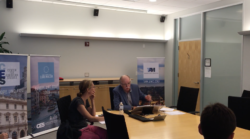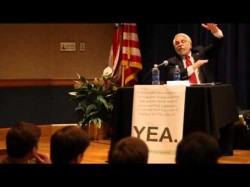Taking the Republicans to Task: (5) On Industrial Policy
The Republican Party likes to pretend (even to itself) that it doesn’t have an industrial policy. It also likes to pretend that the U.S. economy is currently in such deep trouble because the Democratic Party does.
Not so. Both parties have industrial policies whether they acknowledge them or not.
The American economy is in trouble now primarily because the industrial policy to which the Republican Party currently subscribes remains hugely influential and entirely inadequate.
Not that you would know it, of course, if all you listened to was the campaign. The campaign rhetoric is always the same. The U.S. economy is safer in Republican hands, Mitt Romney regularly tells us, because Democrats over-tax, over-spend and over-regulate. Republicans, by contrast, do none of those things. They get government out of the economy. They set the private sector free.[1] They reward rather than penalize initiative, innovation and success.[2] They don’t pick winners and losers. They let market forces do that. They don’t put their trust in bureaucrats.[3] They put their trust instead in the ingenuity and genius of the American people. Like Ronald Reagan before them, modern Republican lawmakers don’t see government as part of the solution. They see it as part of the problem.
Oh that it was that simple, but it is not.
It is not now, and it was not in Ronald Reagan’s day.
It is true that there was a fierce debate within U.S. governing circles in the 1980s between those who favored an active industrial policy geared to strengthening U.S. manufacturing in the face of Japanese competition, and those who did not – and that the latter won that debate, and won it decisively. The Democratic Party under Walter Mondale favored an active industrial policy. The Republican Party under Ronald Reagan didn’t; and the Democrats were so heavily defeated in the 1984 election that for a whole generation thereafter the Reagan position held total sway across both parties. The rhetoric of the Reagan position was that U.S. economic recovery required small government and free markets. The rhetoric was anti-government, even moderately libertarian: but the substance of policy was not. The Reagan Administration was quite willing to use the global weight of the U.S. economy to initially force quotas onto the Japanese, and then to trigger a major revaluation of the Japanese yen – a revaluation that significantly eased international competitive pressures on US-based manufacturing industry. The Reagan Administration was also quite willing to spend heavily on defense, to subsidize oil and agriculture, and to systematically deregulate Wall Street. The Reagan Administration had an industrial policy alright. It was one later characterized (and criticized) by Reagan’s own principal trade negotiator with Asia as:
to over-consume, and to promote weapons production, financial services, construction, medical research and services, agriculture, and oil and gas consumption and production. Further, it [was] both to offshore production and provision of all tradable manufacturing and services as well as, increasingly high-technology R&D, and to expand the domestic retail, food service, and personal medical services industries. At the macro-level, the strategy [was] to run up massive debt and to borrow as much and as long as possible.[4]
Such a gap between rhetoric and reality is always there when Republicans play the “small government” card, because public policy cannot avoid having both a major direct and a major indirect impact on the workings of the private sector. Public policy has an inevitable direct effect on any industry that the federal government privileges by taxation, purchasing or deregulation. Public policy also has an unavoidable indirect effect on the entire private sector, depending on the nature of public policy on each and every aspect of the economy’s physical and social environment. (From public policy on education, training and labor rights on the one side, to policy on consumer protection and environmental regulation on the other.)
We should never fall for the argument that the public and private sectors are necessarily in tension with each other: the case for federal and state economic activity as a supplement to, and a support, for private sector prosperity and growth is well-established.[5] Nor should we fall for the claim that one major American political party does both direct and indirect industrial policy while the other only does indirect. As voters this November, we need to be much more savvy than this. We need to ask all the candidates a set of key questions: what industries do your policies directly favor? How indirectly supportive of economic growth will your entire program actually be? What are the major disagreements on industrial policy between you and your political opponents?
In alerting ourselves to an unavoidable industrial policy debate, there are at least three lessons to be learned from the Reagan years.
- The first is that the federal government can be a very effective leader of industrial change, if it has the institutional capacity and political will to play that role. Don’t let free-market rhetoric mislead you: the United States has long done state-led industrial growth, and it has long done it extremely effectively. It just happens to do it these days primarily in support of America’s global imperial role rather than in support of its domestic economic priorities. In the Reagan years – and indeed since – the Pentagon has acted as the U.S.’s main industry department, and has proved highly effectively at sustaining the global competitiveness and superiority of the American military-industrial complex.[6] There has been no arms-length relationship between government and industry where armaments are concerned. On the contrary, a close public-private partnership has maintained world leadership:[7] so if that partnership works there, why not elsewhere in the U.S. economy also.
- Manufacturing matters. Employment in the service sector is never an adequate substitute for a strong manufacturing base. There can be no long-term strength for an economy that lets its manufacturing base slip away. As the debate around the 1984 election campaign made clear – and recent evidence has merely reconfirmed[8] – manufacturing industries remain the great drivers of productivity growth and high wages in the economy as a whole,[9] and the core centers of crucial linkages that sustain strong service provision and support industries in integrated regional economies.[10] Letting manufacturing relocate abroad corrodes those wages and weakens those linkages: and rebuilding strong regional economies within the territorial United States is hugely more difficult than sustaining the regional economies already in place.[11] Letting manufacturing relocate abroad also drags down American wages across the economy as a whole, and puts in jeopardy the long-term financial security of the entire American middle class.[12]
- Direct and indirect industrial policy come together in an overall growth package – and it is the quality of that growth package that ultimately counts. An industrial policy that deregulates financial institutions and labor markets, tolerates outsourcing and privileges military production over civilian manufacturing, can ultimately only generate an economic growth strategy based on increased income inequality, stagnant wages, and rising personal and international debt. Rakes’ progresses of the kind described by Prestowitz always end in misery. The Reagan growth model, the one that both the Clinton and the Bush administrations then slavishly followed, certainly did: which is why now again, as in the 1980s, it is worth debating whether we need a new set of policies – direct and indirect – to lift the U.S. economy back onto a sustainable growth path.
Is such a set of policies readily available? It is certainly not from the party of Paul Ryan, John Boehner and Mitch McConnell, or from the ever more conservative Mitt Romney.[13] What all these leading Republicans are currently offering is effectively Reagan II: protection of military spending, further deregulation of banking and labor markets, cut backs in public spending on education, infrastructure and healthcare[14] – what The New York Times this morning called “callous choices in the House.”[15] That particular package gave the U.S. economy a period of sustained growth in the 1990s, when the Japanese economy was stalled and China still struggling to shed its Maoist past: but the package hasn’t worked since, and the whole economic edifice it sustained came crashing down in 2008 at great cost to the majority of working Americans. Or rather, the Reagan growth package worked well both before and after 2001 for the CEOs who finance the Republican Party, but not for the bulk of the American electorate, including not for that section which votes Republican because of social agenda concerns.
Is such a set of policies available from the Democrats? Well, not if the Clinton-era orthodoxies remain in place. But then the Reagan-inspired orthodoxies are beginning to erode.[16] The latest Clinton economic plan was definitely a move in the right direction.[17] So was the tone of the 2012 State of the Union Address;[18] and now we have just heard an explicit call for an active industrial policy from the very top of the Obama Administration – from Gene Sperling addressing the Conference on the Renaissance of American Manufacturing. “The economic evidence is increasingly clear,” Sperling said:
…that a strong manufacturing sector creates spillover effects to the broader economy, making manufacturing an essential component of a competitive and innovative economy…when a manufacturing plant chooses to invest in a county, the investment result[s] not just in new production at the site of the plant, but actually increased productivity of other firms in the surrounding area – a concept that economists refer to as an ‘agglomeration spillover.’ Other economic studies reinforce the insight that the location of manufacturing impacts who benefits from such ‘knowledge spillovers.’…such spillover benefits decline with distance, indeed by over half when they are more than 700 miles away…More than any other industry, manufacturing firms account for a disproportionate share of innovative activity in the U.S. – 70 percent of private sector R&D and over 90 percent of patents issued. As a country, it matters where those benefits occur.
The President is on record as wanting further spending on education, on labor training, and on infrastructure. He is on record as wanting to reward manufacturing companies bringing employment back to the United States. No one is campaigning for the reconstruction of low-skilled low-paid textile manufacturing in the U.S. Such industries are presumably permanently and happily gone. The fight now is to attract and sustain the new manufacturing sectors based on sophisticated technology and high labor skills: in industries as important as alternative energy and biotechnology. The President is on record as enthusiastically supporting policies that will bring the U.S. back up to speed on just these industries – the ones now developing rapidly in competitor economies abroad.[19] The President is on record, but are his opponents? If they are, are the policies to which they are wedded likely to be more or less effective than his?
This is one of the big questions for November. Will the U.S. rediscover its capacity for global economic leadership simply by tax-cutting the rich, further deregulating Wall Street and pruning public provision of education, training and infrastructure? Or will that rediscovery require active and sophisticated industrial policy – beginning with infrastructure spending and labor reskilling, and stretching out to new policies on industrial location and income distribution, even perhaps to the questioning of free trade? This choice is surely a no brainer.[20] If only to maintain competitive standing in a world increasingly occupied by overseas economies benefiting from active industrial policy, we need to follow suit. And to pull decent jobs and wages back to the U.S., we need to get ahead of the curve. Markets reward winners and penalize losers. The U.S. has spent a decade losing manufacturing employment and manufacturing wages. Do we really want to spend the next decade doing the same? I sincerely hope that we do not.
[1] https://www.davidcoates.net/2012/03/08/taking-the-republicans-to-task-3-on-smaller-government-smaller-deficits/
[3] https://www.davidcoates.net/2012/02/23/taking-the-republicans-to-task-2-on-the-regulation-of-business-and-labor/
[4] Clyde Prestowitz, The Betrayal of American Prosperity. New York: Free Press, 2010 pp. 270-1
[5] “The Supporting State The adverse economic and social consequences of unregulated market competition provide fertile ground for those who see a positive role for the state in the management of a successful private economy. At the very least, governments have the job of establishing and implementing legal codes protecting the rights of private corporations and of maintaining a high degree of competition between them. Periodic trust busting is a key role for public policy. So too is the regulation and reduction of a string of negative externalities created by unregulated market competition. There is a positive case to be made for taxation, to offset the negative one provided by conservatives – a progressive case advocating taxation as the fairest collective way to finance the long-term upkeep of society. There is a key role for public policy in the protection of the environment, in the maintenance of minimum standards of consumer protection, and in preventing the raiding of corporate funds for illicit private gain. There is also a key role for public policy in offsetting the adverse social consequences of unregulated market competition – creating a welfare net for those unable to work and a retraining net for discarded workers. It is even possible – liberals would say desirable – for the state to go the extra mile and develop an active industrial policy: policy to increase general skill levels in the labor force, to support high-risk high-return research and development, and to create new and complex infrastructures. The state may even have a role in aiding the take-off of new industries, and in setting the bar on labor rights so high as to block off sweat-shop routes to corporate profitability. There is a strong case, that is, for big government as a supplement to private enterprise and as a facilitator of its long-term competitive success.” (David Coates, Making the Progressive Case: Towards a Stronger U.S. Economy. New York, Continuum Books, 2011, p. 48).
See also Josh Bivens, Public Investment: The next ‘new thing’ for powering economic growth, EPI Briefing Paper #338, April 18, 2012: available at http://www.epi.org/publication/bp338-public-investments
[6] Gregory Hooks, “The Rise of the Pentagon and U.S. State Building: The Defense Program as Industrial Policy,” American Journal of Sociology, 96(2), September 1990, pp. 358-404
[7] David Vogel, Kindred Strangers: The Uneasy Relationship between Politics and Business in America. Princeton, Princeton University Press, 2011, p. 115
[8] See Michael Ettlinger and Kate Gordon, The Importance and Promise of American Manufacturing. Washington DC: Center for American Progress, April 2011: available at http://www.americanprogress.org/issues/2011/04/manufacturing.html
[9] See Robert E. Scott, Memo to the Times: Hold the funeral march for U.S. manufacturing (posted April 10, 2012: available at http://economyincrisis.org/content/memo-to-the-times-hold-the-funeral-march-for-u-s-manufacturing). And Lawrence Mishel, Robert Lawrence misleads the New York Times on manufacturing (posted April 11, 2012: available at http://www.epi.org/blog/robert-lawrence-new-york-times-american-manufacturing/)
[10] “Linkage, Not Succession…At the heart of our argument is a contention that…tight linkages tie a broad core of service jobs to manufacturing ….Shift out of manufacturing, and it is more likely that you will find that you have shifted out of such services as product and process engineering, than into those services.” (Stephen s. Cohen and John Zysman, Manufacturing Matters: The Myth of the Post-Industrial Economy. New York: Basic Books, 1988, p. 7)
[11] For the latest data on continuing outsourcing, see David Wessel, “Big U.S. Firms Shift Hiring Abroad,” The Wall Street Journal, April 19, 2012: available at http://online.wsj.com/article/SB10001424052748704821704576270783611823972.html
[12] For the contemporary case, see Jerry Jasinowski, Manufacturing is Different, posted on The Huffington Post April 2, 2012: available at http://www.huffingtonpost.com/jerry-jasinowski/manufacturing-is-differen_b_1396331.html
[13] The Romney economic blueprint issued in 2011, Believe in America, has 59 policy proposals, no one of which directly addresses U.S. manufacturing. For the complexities of Mitt Romney’s current position on economic policy, see “Work in Progress,” The Economist, April 21, 2012: available at http://www.economist.com/node/21553030
[14] See Jennifer Haberkorn and Jonathan Allen, “GOP pits defense vs. health law,” Politico, April 19, 2012: available at http://www.politico.com/news/stories/0412/75382.html
[16] See Edward Luce, ‘America reassembles industrial policy,” The Financial Times, April 8, 2012: available at http://www.ft.com/intl/cms/s/0/6cbeb150-7da4-11e1-bfa5-00144feab49a.html#axzz1srbqtjAX
[17] Bill Clinton, Back to Work: Why We Need Smart Government for a Strong Economy. New york: Knopf Doubleday, 2011
[18] “No, we will not go back to an economy weakened by outsourcing, bad debt, and phony financial profits. Tonight I want to speak about how we move forward, and layout a blueprint for an economy that’s built to last – an economy built on American manufacturing, American energy, skills for American workers, and a renewal of American values. The blueprint begins with American manufacturing.” (Barack Obama, State of the Union Address, January 24, 2012: available at http://www.whitehouse.gov/the-press-office/2012/01/24/remarks-president-state-union-address)
[19] On this, see Devon Swezey and Ryan McConaghy, Manufacturing Growth: Advanced Manufacturing and the Future of the American Economy. Washington DC: Breakthrough Institute/The Schwartz Initiative on American Economic Policy, October 2011: available at http://thebreakthrough.org/blog/2011/10/manufacturing_growth_advanced.shtml
[20] Certainly it is a debate primarily now between academics and researchers on the center-left. Free-market orthodoxies run too deep to permit its development in more conservative circles. For a representative sample, see John Podesta, Sarah Rosen Wartell and Jitinder Kohli, A Focus on Competitiveness. Washington DC, Center for American Progress, 2010, available at http://www.americanprogress.org/issues/2010/12/focus_on_competitiveness.html ;
The White House, A Strategy for American Innovation: Securing Our Economic Growth and Prosperity. Washington DC, 2012, available at http://www.whitehouse.gov/innovation/strategy ;
Daniel Alport, Robert Hockett and Nouriel Roubini, The Way Forward, Washington DC, The New Foundation, 2011, available at http://newamerica.net/publications/policy/the_way_forward ;
Nisha Mistry and Joan Byron, The Federal Role in Supporting Urban Manufacturing. Washington DC, Brookings, 2011: available at http://www.brookings.edu/papers/2011/04_urban_manufacturing_mistry_byron.aspx
Tags: 2012 election, Barack Obama, Democractic Party, Gene Sperling, growth strategies, industrial policy, manufacturing, Mitt Romney, Obama administration, out-sourcing, Republican Party, Ronald Reagan, wages, Wall Street
David Coates holds the Worrell Chair in Anglo-American Studies at Wake Forest University. He is the author of Answering Back: Liberal Responses to Conservative Arguments, New York: Continuum Books, 2010.
He writes here in a personal capacity.





